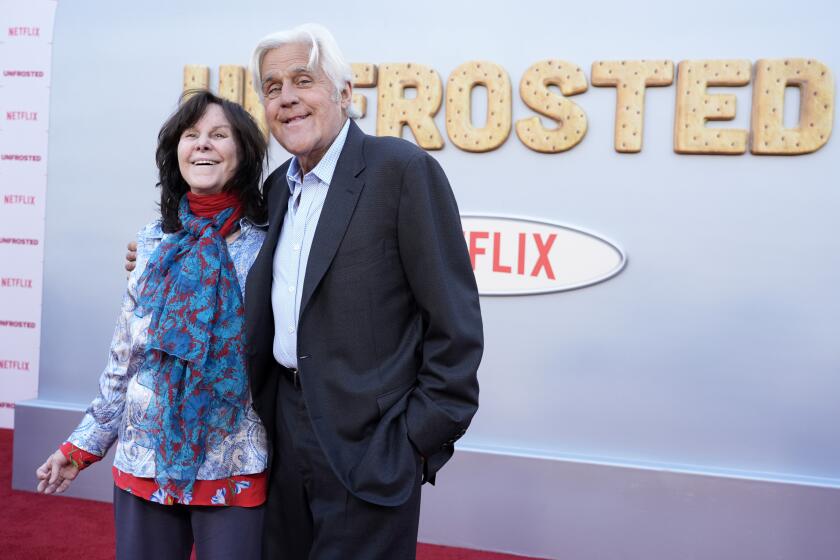ART REVIEW : THE WAY WE ARE, FIGURATIVELY
- Share via
If you’re seeking a cultural excuse to visit Palm Springs, look no further than “California Figurative Sculpture.” The exhibition of 55 works by 18 sculptors at the Palm Springs Desert Museum (through March 15) is an invigorating minisurvey of a genre that’s usually seen piecemeal, in solo exhibitions.
Making something of a grand coastal sweep, curator Catherine Plake Hough has chosen 11 artists from the northern end of the state and seven from the southern sector as she plucked representatives of stylistic variations from trompe l’oeil realism to figurative abstraction. You’ll find Robert Graham’s perfect bronze nudes bumping heads with Dennis Gallagher’s rough clay suggestions of figures. Ron Cooper and Peter Shelton both show hollow, wall-mounted torsos, but Cooper’s extravagantly glazed ceramic shells provide a sharp contrast with Shelton’s midnight purple “Sleepwalker,” whose outstretched arms seem to go on forever. Cooper seems to present bodily fragments as coats of armor--glitzy, hard coatings that mask vulnerable people--while Shelton goes for the soul in dark, sleek forms devoid of detail.
Look one direction in the spacious galleries and you’ll discover Italo Scanga’s Cubist “Abstract Figure With Cello,” or Robert Hudson’s jaunty, mechanistic construction, called “Plumb Bob.” If the literal-minded have difficulty identifying the figures in those works, John De Andrea’s unbelievably real sculpture of an artist and his nude model is so convincing that it causes the modest to avert their eyes in embarrassment.
Something for everyone?
Not really. Despite the variety of styles and materials, “California Figurative Sculpture” is not a complete survey, nor does it claim to be. Instead, you can leave the provocative medley feeling that you know something about a manageable group of artists.
People who visit the Palm Springs museum for a pleasant diversion may find the exhibition dismaying, however, because it has a pessimistic flavor that probably wasn’t intended, but it is acknowledged in the catalogue. The general tenor of about three-quarters of the work runs from vaguely unsettling to profoundly disturbing--from Elaine Carhartt’s strange, mythical personages to Robert Arneson’s indictments of the military.
Jonathan Borofsky makes the most noise with his familiar, electronically powered “Chattering Man,” who yammers on incessantly while staring at a spattered canvas called “Blue Raindrop Painting.” This work--produced in multiples and shown in various contexts--will surely go down as one of the late 20th Century’s most trenchant statements and pointed images.
Arneson’s three ceramic busts make a silent commotion about armed insanity. All are powerful, but “The Colonel” takes top honors. He’s a grisly, white-faced relic with black holes for eyes and a chestful of medals, sitting on a pedestal of writhing corpses.
Viola Frey holds up her corner of the show with a couple of towering ceramic figures and a mammoth piece called “The Group.” If middle-class aggression has been a subtle subtext in her past work, it erupts in this figurative conglomeration.
It’s good to have another look at Roland Reiss’ big mixed-media figures and architectural fragments, done in 1985, because a return visit confirms their conceptual relevance and quality. Staggering under the weight of a Post-Modern society, these people are a wise blend of noble purpose and robotic mindlessness.
Other artists broach questions on the meanings of art in contemporary life less directly. Oliver Jackson, for example, carves realistic figures emerging from blocks of wood or marble, as if to weigh a human image against a natural material. Stephen De Staebler gives his imposing bronze “Pregnant Woman” the air of a great hulking cadaver, while Nathan Oliveira’s small bronzes personify poignancy and ambivalence.
There are no heroic images in “California Figurative Sculpture,” no moral catharsis. As for drop-dead beauties, De Andrea’s nude is both too real and too introspective to be seductive and Graham’s lithe figures are naturalistic likenesses of youth and self-absorption that only make you think they’re ideal.
The show isn’t about perfection; the ravaged, the twisted, the misguided, the confused and the frustrated far outnumber images of wholeness and contentment. But the tenor of the exhibition is neither depressing nor cynical. It brims with life as the art goes about its business of conveying ideas of how it feels to be human.
More to Read
The biggest entertainment stories
Get our big stories about Hollywood, film, television, music, arts, culture and more right in your inbox as soon as they publish.
You may occasionally receive promotional content from the Los Angeles Times.










